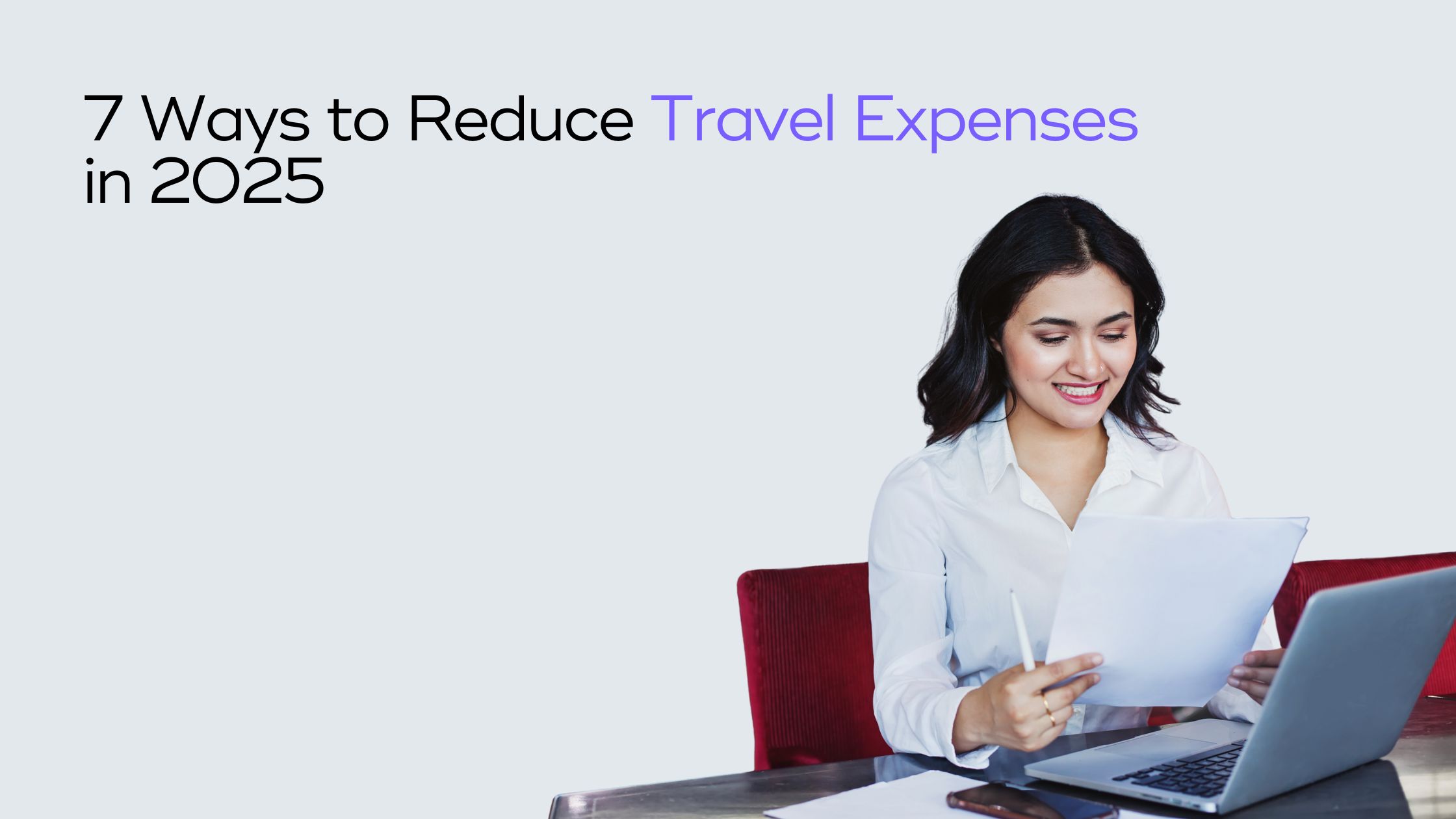Are you still managing business trips without a proper travel management system—and watching your costs spiral out of control?
As an HR professional or CXO trying to balance employee needs with company budgets, you know how fast travel expenses can pile up especially in 2025, where inflation, dynamic pricing, and last-minute approvals are the new norm.
And you know the real challenge isn’t just about reducing travel, it’s about reducing unnecessary spending while keeping your teams mobile, motivated, and compliant.
So how do you do that?
Let’s walk you through 7 ways you can cut down travel costs without compromising on business goals or employee experience.
1. Centralize All Bookings in One Place
One of the biggest reasons travel costs spiral is when bookings are handled in a scattered way across apps, vendors, and individual employees.
Without a centralized travel management system, it’s tough to know how much is being spent, where, and by whom.
By centralizing your travel process brings all bookings under one roof- flights, hotels, cabs, everything. It gives your team full visibility over travel spending, helps finance teams reconcile expenses faster, and allows HR to set proper approval workflows.
Most importantly, it makes it easier to detect patterns of overspending and negotiate better deals with vendors through consolidated volumes.
And according to the skift report, 77% of managers say they prefer an all-in-one travel and expense platform for exactly this reason.
When you centralize travel, you’re not just streamlining operations—you’re building a foundation for cost control.
2. Use Corporate Negotiated Rates
If your teams are booking hotels or flights at whatever rate is available on the day of travel, you’re likely overspending without realizing it.
Businesses that work with preferred vendors or set up corporate rate agreements save significantly—often 15–25% per booking.
Why?
Because vendors offer better pricing when they know you’ll give them consistent business. Whether it’s hotel chains, airlines, or ground transport providers, working with select partners also gives you benefits like better availability during peak seasons, priority support, and lower cancellation fees.
Even if you don’t have the bandwidth to negotiate contracts yourself, partnering with a travel booking platform that already has those tie-ups can help you access those same savings effortlessly.
3. Define a Clear, Flexible Travel Policy
Do your employees know exactly what’s allowed when they travel for work?
If the answer is “not really,” that’s costing you more than you think.
When policies are vague or not followed, people end up booking expensive hotels, business class flights, or cabs without approval—without even knowing they’re doing something wrong.
But if you set a clear, simple, and flexible travel policy one that outlines budgets, travel classes, booking timelines, and reimbursement rules you remove the guesswork.
And when that policy is actually built into your system, it becomes a natural part of how people book.
You don’t need to micromanage, just guide.
4. Encourage Early Planning to Unlock Lower Prices
Last-minute bookings are one of the biggest reasons travel budgets overshoot.
You’ve probably seen it yourself booking a flight the day before versus a week in advance can increase the cost by 30–50%. The same holds true for hotel stays, especially during peak seasons or in high-demand cities.
That’s why encouraging your employees to plan their trips in advance is one of the simplest and most effective ways to cut costs.
It’s not about restricting urgent travel those situations will always exist but building a process where trips are requested and approved with enough lead time.
In fact, reports show that 44% of business travelers book travel 1–2 weeks in advance to balance flexibility with competitive rates. Even better, 40% plan more than a month ahead to take advantage of early-booking discounts. That’s a trend worth following.
As HR, you can easily introduce small changes, internal reminders, booking window policies, or even soft nudges in your travel platform to help your teams plan earlier.
Over time, that one habit alone can create a noticeable drop in your overall travel spend.
5. Use Travel Data to Drive Smarter Decisions
When was the last time you looked at your travel data and actually used it to make decisions?
If you’re like most HR teams or finance leads, travel spend is probably buried in spreadsheets or scattered across invoices. That makes it really hard to see where the leaks are.
But when you start tracking- really tracking- you’ll start noticing patterns. Maybe one department always books last-minute flights. Maybe certain cities have unusually high hotel spends. Maybe some bookings are constantly outside of policy.
And once you have that insight? You’re no longer guessing. You’re optimizing.
6. Automate the Entire Travel Workflow
Still managing travel requests through emails, WhatsApp messages, and back-and-forth calls?
That’s not only time-consuming it also increases the chances of costly errors, missed approvals, and inconsistent bookings.
Automating your travel workflow from request to booking to approval reduces manual work and brings consistency.
It allows your HR and finance teams to focus on strategic tasks rather than chasing down invoices or fixing last-minute issues.
Automation also ensures policy compliance in real-time, sends automated reminders for early bookings, and lets employees handle cancellations or rescheduling with minimal effort.
In short, it makes travel smoother for everyone while saving money at every stage.
7. Rethink What Needs to Be Travelled For
Here’s a question worth asking: Is this trip really necessary?
Business travel is valuable, no doubt. But not every internal review, vendor catch-up, or monthly meeting needs a flight ticket and hotel stay. With hybrid work tools, a lot of these can happen virtually saving you both time and money.
That doesn’t mean eliminating travel. It means being intentional with it.
Reserve in-person travel for moments that matter: client pitches, onboarding, offsites, high-stakes meetings.
And cut down the rest. When every trip has a purpose, your travel budget suddenly starts working for you, not against you.
Before You Wrap Up Let’s Talk About CoTrav
Now, you might be thinking- this all sounds great, but who has the time to build all of this from scratch?
That’s exactly where a travel management system like CoTrav steps in.
All these strategies are effective but they’re even more powerful when managed through the right travel management system.
That’s where CoTrav helps.
CoTrav is a modern travel management system platform built specifically for businesses like yours.
It brings everything- bookings, policies, vendors, approvals, data, and support into one place. You don’t need to juggle between apps or emails. Instead, you get full visibility, automated workflows, cost-saving features, and 24×7 assistance.
Whether you’re an HR trying to simplify processes or a CXO looking to gain better control of budgets, CoTrav helps you do both without compromising employee experience.
Conclusion
Cutting travel costs in 2025 isn’t about restricting travel, it’s about managing it strategically.
When you centralize the process, use negotiated rates, build clear policies, and automate the system, you naturally reduce unnecessary expenses.
And when you combine these efforts with a smart travel management system platform like CoTrav, you unlock the real potential of business travel: cost control, operational efficiency, and better employee satisfaction—all at once.
Ready to travel smarter, not harder?
Let 2025 be the year you finally take control of your travel budget with confidence.
FAQs
1. What is a travel management system and how does it reduce business travel costs?
A travel management system helps streamline bookings, approvals, and policies to reduce overall business travel expenses.
2. How can travel and expense management software help my company save money?
Travel and expense management software automates approvals and tracks spending to control costs effectively.
3. Is it worth investing in travel and expense management services for SMEs?
Yes, travel and expense management services help SMEs reduce manual work and manage budgets better.
4. What’s the difference between travel management and travel expense management?
Travel management handles bookings, while travel expense management focuses on cost tracking and reimbursements.
5. Can CoTrav help manage both travel bookings and expense tracking? Yes, CoTrav offers a complete travel and expense management system for seamless bookings and expense control.




